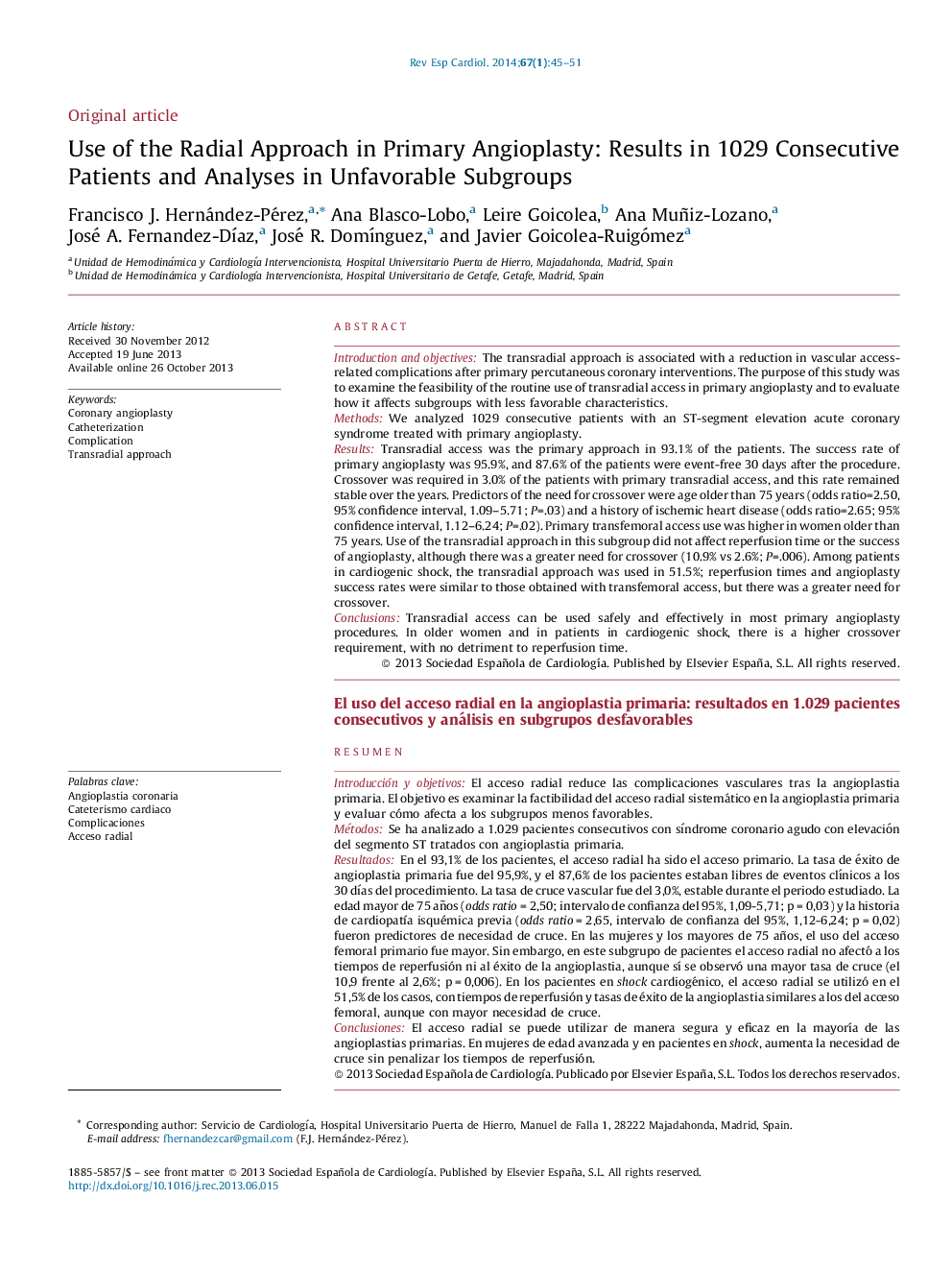| کد مقاله | کد نشریه | سال انتشار | مقاله انگلیسی | نسخه تمام متن |
|---|---|---|---|---|
| 3017645 | 1182127 | 2014 | 7 صفحه PDF | دانلود رایگان |
Introduction and objectivesThe transradial approach is associated with a reduction in vascular access-related complications after primary percutaneous coronary interventions. The purpose of this study was to examine the feasibility of the routine use of transradial access in primary angioplasty and to evaluate how it affects subgroups with less favorable characteristics.MethodsWe analyzed 1029 consecutive patients with an ST-segment elevation acute coronary syndrome treated with primary angioplasty.ResultsTransradial access was the primary approach in 93.1% of the patients. The success rate of primary angioplasty was 95.9%, and 87.6% of the patients were event-free 30 days after the procedure. Crossover was required in 3.0% of the patients with primary transradial access, and this rate remained stable over the years. Predictors of the need for crossover were age older than 75 years (odds ratio=2.50, 95% confidence interval, 1.09–5.71; P=.03) and a history of ischemic heart disease (odds ratio=2.65; 95% confidence interval, 1.12–6.24; P=.02). Primary transfemoral access use was higher in women older than 75 years. Use of the transradial approach in this subgroup did not affect reperfusion time or the success of angioplasty, although there was a greater need for crossover (10.9% vs 2.6%; P=.006). Among patients in cardiogenic shock, the transradial approach was used in 51.5%; reperfusion times and angioplasty success rates were similar to those obtained with transfemoral access, but there was a greater need for crossover.ConclusionsTransradial access can be used safely and effectively in most primary angioplasty procedures. In older women and in patients in cardiogenic shock, there is a higher crossover requirement, with no detriment to reperfusion time.
ResumenIntroducción y objetivosEl acceso radial reduce las complicaciones vasculares tras la angioplastia primaria. El objetivo es examinar la factibilidad del acceso radial sistemático en la angioplastia primaria y evaluar cómo afecta a los subgrupos menos favorables.MétodosSe ha analizado a 1.029 pacientes consecutivos con síndrome coronario agudo con elevación del segmento ST tratados con angioplastia primaria.ResultadosEn el 93,1% de los pacientes, el acceso radial ha sido el acceso primario. La tasa de éxito de angioplastia primaria fue del 95,9%, y el 87,6% de los pacientes estaban libres de eventos clínicos a los 30 días del procedimiento. La tasa de cruce vascular fue del 3,0%, estable durante el periodo estudiado. La edad mayor de 75 años (odds ratio = 2,50; intervalo de confianza del 95%, 1,09-5,71; p = 0,03) y la historia de cardiopatía isquémica previa (odds ratio = 2,65, intervalo de confianza del 95%, 1,12-6,24; p = 0,02) fueron predictores de necesidad de cruce. En las mujeres y los mayores de 75 años, el uso del acceso femoral primario fue mayor. Sin embargo, en este subgrupo de pacientes el acceso radial no afectó a los tiempos de reperfusión ni al éxito de la angioplastia, aunque sí se observó una mayor tasa de cruce (el 10,9 frente al 2,6%; p = 0,006). En los pacientes en shock cardiogénico, el acceso radial se utilizó en el 51,5% de los casos, con tiempos de reperfusión y tasas de éxito de la angioplastia similares a los del acceso femoral, aunque con mayor necesidad de cruce.ConclusionesEl acceso radial se puede utilizar de manera segura y eficaz en la mayoría de las angioplastias primarias. En mujeres de edad avanzada y en pacientes en shock, aumenta la necesidad de cruce sin penalizar los tiempos de reperfusión.
Journal: Revista Española de Cardiología (English Edition) - Volume 67, Issue 1, January 2014, Pages 45–51
